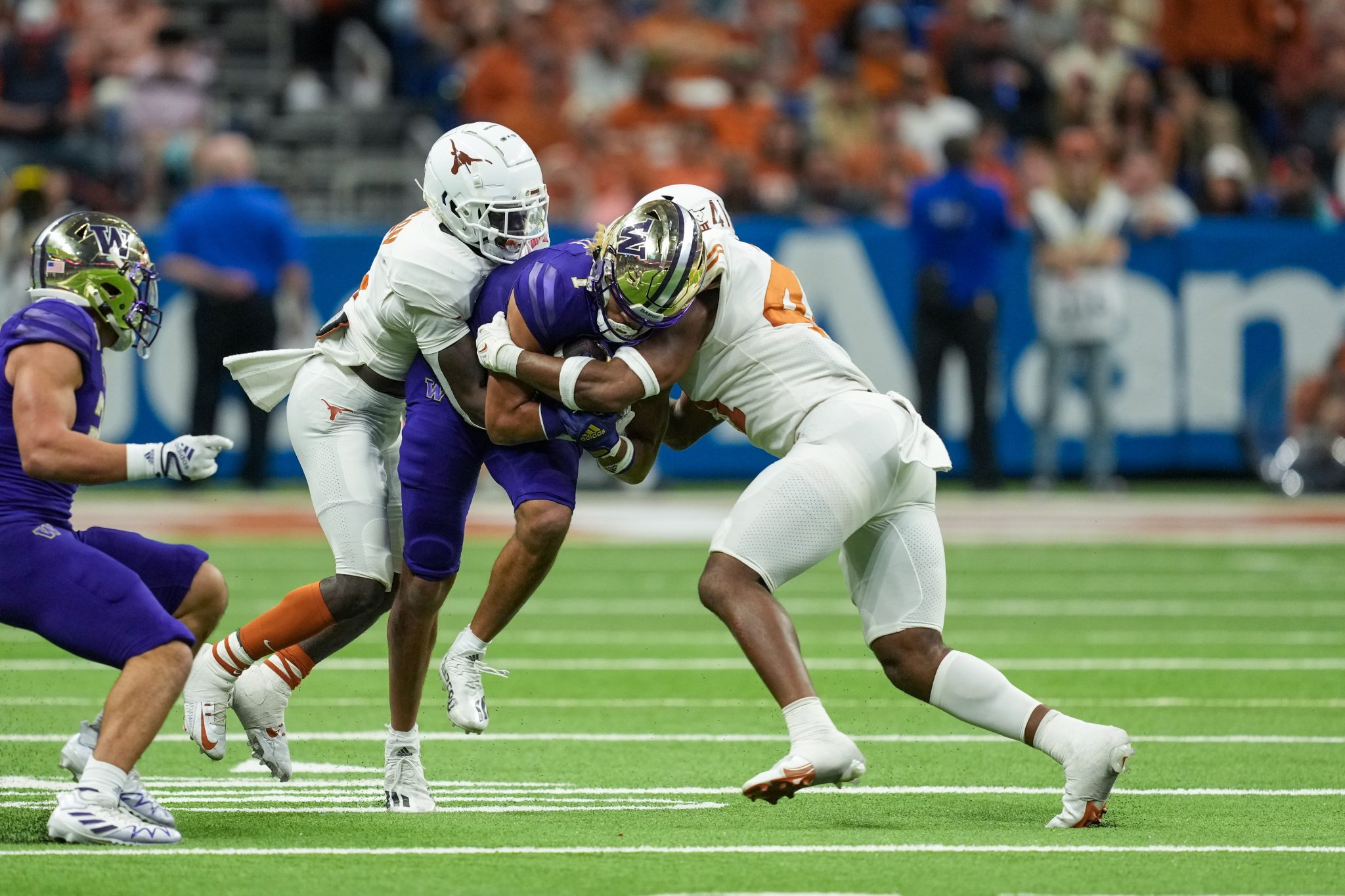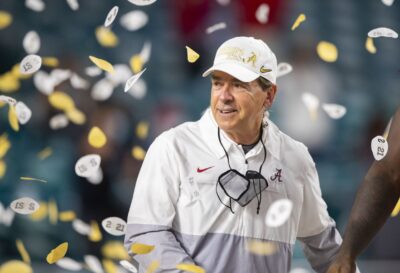
Texas vs. Washington is a matchup of programs that will be looking to clinch their first national championship game appearance of the College Football Playoff era.
Both of these teams have intriguing statistical profiles that, for the most part, match their public perception. Washington’s offense is elite in nearly every facet while its defense is much more vulnerable than you’d expect from a semifinalist. Texas is more well-balanced than Washington, but lacks some of the truly elite traits that you usually see from a team in its position.
It’s worth noting off the top that these teams met in the Alamo Bowl just last season — a game Washington won 27-20.
Let’s examine some betting trends, advanced stats and other useful info about these teams:
Texas vs. Washington Betting Lines
Spread: Texas -4 (DraftKings)
Total: Over/under 63.5 points (DraftKings)
Check out these excellent sports betting apps to get in on the action ahead of Monday’s big Playoff game.
Betting trends to know for Texas
- Texas is 7-6 against the spread this season
- UT has covered 3 games in a row
- The over is 5-8 in Texas games this season
- Texas is 6-6 against the spread as the favorite this season
- Texas is 0-2 against the spread this season when favored by 4 points or less
Texas has rarely been a short favorite this season — it only happened against Oklahoma and Kansas State. The Longhorns lost to Oklahoma as 4-point favorites back in October but squeezed out a 33-30 win over K-State as 3.5-point favorites in November. Over the past 2 seasons, Texas is 15-11 against the spread overall.
Betting trends to know for Washington
- Washington is 6-6-1 against the spread this season
- The over is 6-7 in Washington games this season
- Washington is 2-0 as an underdog this season
Washington has been pretty good in this spot, albeit in a limited sample. The Huskies were underdogs to Oregon State and Oregon during the month of November and won both of those games outright away from home. In the Kalen DeBoer era, Washington is 14-11-1 against the spread overall and 4-0 against the spread as the underdog. One of those wins as a dog came against Texas last season in the Alamo Bowl. The Huskies won that game 27-20 as 3-point underdogs.
Résumé rankings
Via ESPN’s Football Power Index:
- Texas strength of schedule: 19th
- Washington strength of schedule: 15th
- Texas strength of record: 5th
- Washington strength of record: 1st
Advanced Stats preview
Success rate will be the primary tool referenced in this section. Whether or not a play is “successful” depends on the down and distance of a given play. Here’s a breakdown of how much yardage is necessary for a play to be deemed “successful”:
- 1st down: Teams must gain at least 50% of required yardage
- 2nd down: Teams must gain at least 70% of required yardage
- 3rd or 4th down: Teams must gain 100% of required yardage
Defensively, numbers are presented as what the defense allowed the offense to achieve. So on defense, a 35% success rate is better than a 40% success rate.
Let’s dig into what success rate says about this matchup:
Rushing Success Rate
- Texas rushing offense success rate: 42% (40th percentile)
- Washington rushing defense success rate: 51% (5th percentile)
Right off the bat, we get a major weakness for one of our semifinalists. Washington’s inability to stop the run is why there was so much doubt that the Huskies could finish off their undefeated season. It’s also the primary reason why Washington was an underdog to Oregon in the Pac-12 Championship Game. And to Washington’s credit, it did a great job against the Ducks’ rushing attack in that title game. It limited Bucky Irving to just 20 yards on 9 carries. Bo Nix was very effective as a runner (69 yards on 6 carries) in that game, but that’s not much of a concern in this game with Quinn Ewers under center.
The running game has not been a major strength for the Longhorns, but it’s not really a weakness either. Star running back Jonathon Brooks hasn’t played since Nov. 11 after suffering a season-ending knee injury. Jayden Blue and CJ Baxter have each had 100+ yard games since Brooks went down.
- Washington rushing offense success rate: 54% (98th percentile)
- Texas rushing defense success rate: 33% (96th percentile)
This is a fascinating matchup. Led by Dillon Johnson, Washington has one of the more effective running games in the country by success rate. Johnson enters this CFP matchup with 1,113 yards and 14 touchdowns. However, the Longhorns’ run defense is legit. Texas hasn’t given up more than 4 yards per carry since the Oklahoma game on Oct. 7. It held Alabama to just 3.1 yards per rush on 35 attempts in Tuscaloosa.
The only thing preventing this from being the most important matchup of the game is Washington’s rushing rate. The Huskies much prefer to throw it around the yard with Michael Penix Jr. They ran it only 43% of the time this season — and that was against defenses that were much less-likely to stonewall them than Texas is. I’d expect a relatively low rushing output from Washington in this game — both in attempts and yardage.
Passing Success Rate
- Texas passing offense success rate: 48% (89th percentile)
- Washington passing defense success rate: 40% (64th percentile)
Texas runs the ball over 50% of the time, and I’d bank on that trend continuing in the CFP against Washington’s porous run defense. But the Longhorns have been excellent through the air as well offensively. Ewers has had a strong season and is averaging 9 yards per attempt, so he is more than capable of being efficient against this Washington secondary. It’s worth noting that Texas star receiver Xavier Worthy (969 yards this season) suffered an injury in the Big 12 Championship Game and may not be 100% for this matchup. AD Mitchell is the only other Texas wide receiver who has more than 500 receiving yards this year.
- Washington passing offense success rate: 53% (96th percentile)
- Texas pass defense success rate: 38% (80th percentile)
This is the area that Washington simply has to dominate if it is going to pull off this upset. As Oregon found out again in the Pac-12 title game, Washington’s superpower is its wide receivers. Rome Odunze, Jalen McMillan and Ja’Lynn Polk are all incredibly difficult to contain. Penix has done a phenomenal job throughout the year of hitting those receivers in open space — that will have to continue on Monday for the Huskies to have a realistic chance of winning.
Texas’s pass defense has been solid, but it’s not as good as its rush defense. The Horns have been vulnerable through the air at times this season — games against Houston, Kansas State, TCU and Iowa State standout in that regard. All of those teams threw for over 300 yards on the Longhorns on decent efficiency, and none had a passing offense anywhere close to as potent as Washington’s. This is a major concern for Texas.
Havoc rate
A havoc play is defined as a play where the defense records a tackle for loss, a forced fumble, an interception or a pass breakup.
For defenses, a higher havoc rate is good. Offensively, havoc rates are presented as what the offense allowed the defense to create. On that side of the ball, the lower the havoc rate, the better it is for your offense.
Here’s a breakdown of this matchup:
- Texas offensive havoc rate: 14% (84th percentile)
- Washington defensive havoc rate: 15% (25th percentile)
This is a major advantage for Texas. Even playing in the Pac-12, Washington struggled to generate a pass rush all season. The Huskies recorded just 19 sacks in 13 games, which is by far the lowest total of any Pac-12 program in 2023. Washington also ranked near the bottom of the conference in tackles for loss and forced fumbles. Washington’s pass defense survived mostly by creating interceptions, as it led the Pac-12 with 16 this season. Ewers only threw 6 interceptions all season, so that strategy could be problematic for Washington.
- Texas defensive havoc rate: 19% (80th percentile)
- Washington offensive havoc rate: 13% (93rd percentile)
Texas is excellent at getting opposing offenses behind the chains. The Longhorns rank near the top of the Big 12 in both sacks and tackles for loss in 2023. Washington isn’t a pushover in this area, however. The Huskies have only allowed 46 tackles for loss this season, which is second only to Oregon among Pac-12 programs.
Points per opportunity
A scoring “opportunity” is defined as a possession in which the offense has moved the ball beyond the opponents’ 40-yard line. This stat measures how effective a team is at cashing on its scoring chances — or preventing them from their opponents.
- Texas points scored per opportunity: 3.84 (46th percentile)
- Washington points allowed per opportunity: 3.93 (40th percentile)
This is an area where both teams struggled quite a bit this season. For Texas, the issue was an over-reliance on field goals and general inefficiency in the red zone. The Longhorns made 17 red zone field goals this season, which accounts for just under 31% of all their red zone trips in 2023 (2nd-highest mark in the Big 12). Texas also came up completely empty on 20% of its red zone possessions this year. Texas is one of just 14 teams nationally who scored a touchdown on less than 50% of its red zone possessions in 2023.
For Washington, it has given up points on more than 84% of its defensive red zone possessions this season. The Huskies are one of 3 Pac-12 teams who conceded touchdowns on north of 70% of its defensive red zone possessions this year. The other 2 are Stanford and Cal — not exactly great company for a defense that’s preparing for a CFP semifinal.
- Washington points scored per opportunity: 4.73 (90th percentile)
- Texas points allowed per opportunity: 3.43 (74th percentile)
Washington is one of the most efficient offenses in the country from anywhere on the field, but especially once it gets deep into opposing territory. The Huskies scored 45 red zone touchdowns this season, which is tied for 8th nationally. The Huskies were also great on 4th down this season — 11-of-15 on the year — which is a trend they will likely need to continue vs. Texas.
Texas had the Big 12’s best red zone defense this season. The Longhorns allowed opponents to score on just 71.4% of their red zone possessions. Texas’ pass defense really tightened up in the red zone, allowing a completion percentage of just 48.1% on those attempts.
Tracking efficiency
- Texas offense: 18th
- Texas defense: 7th
- Texas special teams: 20th
- Washington offense: 5th
- Washington defense: 30th
- Washington special teams: 23rd
- Texas offense: 6th
- Texas defense: 10th
- Texas special teams: 17th
- Washington offense: 4th
- Washington defense: 45th
- Washington special teams: 46th
Note: All advanced stats mentioned in this story are from CollegeFootballData.com unless otherwise noted. Betting trends are via the Sports Betting Dime database.
Spenser is a news editor for Saturday Down South and covers college football across all Saturday Football brands.







